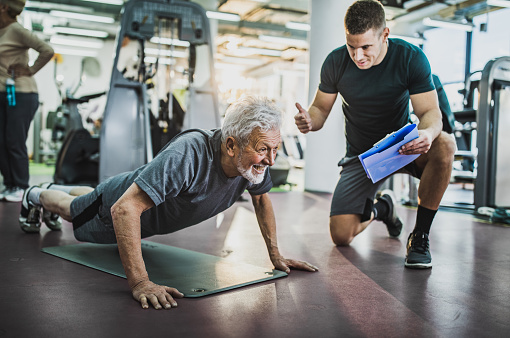How Can Older's Improve Their Health Through Exercise
RESISTANCE EXERCISE: A MUST FOR OLDER'S ...


Resistance exercise has already been documented as beneficial to muscle health of course, but also to bone health, it also helps prevent the risk of certain diseases, including type 2 diabetes. This Michigan Medicine study tells us why and how resistance training is essential for the health of the elderly, evidence from the literature to support it.
Yet, for many older people, resistance exercise is not a part of everyday life. One of the reasons why very few seniors see themselves living as 100 years old is that the majority of them associate old age with physical and cognitive decline, loss of autonomy and poor quality of life, explains the lead author, Dr. Mark Peterson, associate professor of physical medicine and rehabilitation in Michigan. Still, it is possible, with certain lifestyle measures, to live old and healthy.
Strength and resistance, for healthier aging
This position paper, supported by the National Strength and Conditioning Association, highlights the benefits of strength and resistance training in the elderly for healthier aging. While aging takes a toll on the body, there are evidence-based recommendations, including exercise focused on building muscle and endurance:
11 proven practical interventions: each intervention is described via 4 items: its design and indications, the associated physiological adaptations, its functional advantages and its effects relating to frailty, sarcopenia and other chronic conditions. The authors also offer suggestions on the number of repetitions, intensity of practice, and targeting interventions to specific groups of patients. Finally, they describe how these different programs can be adapted to elderly people with disabilities or living in specialized care establishments.
Extension of survival
Improved quality of life (eg, endurance, strength, mood, flexibility, quality of sleep, cognitive function)
In addition, many older adults are unaware of the level of difficulty of the exercises and do not know how much exercise they can do.
Exercise is one of the safest methods to improve health. Given the decline in physical capacity due to aging and the disorders that are more common in older people, they may benefit more from exercise than younger people. Exercise brings proven benefits even when you start it at an advanced age. A modest basic bodybuilding helps the elderly to carry out activities of daily living.
The greatest health benefits, especially with aerobic exercise, are obtained when people who are not physically active begin to exercise.
Strength decreases with age, and a decrease in strength can compromise function. Strength training can increase muscle mass and improve function significantly. With more muscle mass, the same amount of muscle work requires less cardiovascular effort. Increasing muscle strength in the legs improves walking speed and the ability to climb stairs. Older people who exercise are more likely to have a better prognosis during critical illness.
Not all older people can exercise safely. Some heart conditions and uncontrolled high blood pressure or diabetes mellitus can make exercise dangerous for some people. Other conditions, such as arthritis, can make it difficult to exercise. However, most seniors, even those with heart conditions, can exercise. They may need to follow a specially designed exercise program or work out under the supervision of a doctor, physical therapy or coach. People should stop exercising and seek medical help if they develop chest pain, dizziness, or are aware of irregular or rapid heartbeat (palpitations) during exercise.
Before starting an exercise program, older people should be evaluated by their doctor for heart problems and physical limitations to exercise. An electrocardiogram (ECG) is not usually necessary unless the person's medical history or physical examination findings suggest a problem. Ergometric stress testing is generally not necessary in older adults who plan to start exercising slowly and increase in intensity only gradually. Doctors may perform stress testing for people who are not physically active and plan to start strenuous exercise, especially if doctors suspect that such people have diabetes, a lung disorder, or a heart problem.
In this gentle gym program for seniors, you will discover 50 fun exercises to do at home, without specific equipment.
Each video offers an exercise. It's up to you to choose the ones that interest you in order to build your own gymnastics session. If you want the help of a partner - be it a caregiver or a family member - you can also select the exercises designed specifically for.
The series of proposed movements is suitable for a beginner. As you train, you can go further by applying the variations offered in the videos. Before following this guide, be sure to check with your doctor that you are physically fit for a gentle workout.
This program was developed in collaboration with sports coaches specialized in physical activity adapted for seniors.
It is based on 5 major axes: softening your joints, strengthening your muscles, working on your cardio, improving your balance to prevent falls and finally, adopting a good posture during everyday activities.
Before starting the exercises, we advise you to follow one of the warm-up sessions; then finish with a stretching video.
The practice of regular physical activity, for people advancing in age, is a great weapon against a sedentary lifestyle. In addition to providing a more fulfilling social life, sport has the advantage of preserving health and independence.
Good session !
Comments
Post a Comment